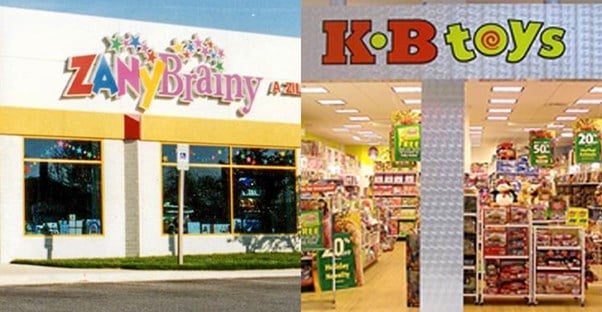K-B Toys

This mall-based chain of retail toy stores began in 1922 as a wholesale candy store called Kaufman Brothers. It was founded by brothers, Jerry Kaufman and Harry Kaufman, who opened a wholesale toy store in 1946. At that time, they decided to focus on the toy industry and kept only a small portion of candy in their stores. The name was shortened to K-B Toys and it was a mall staple for many years.
At one time, there were 461 locations and it was the second-largest toy store chain in the United States. Headquartered in Pittsfield, MA, the stores ceased operations on February 9, 2009.
Gadzooks

With the Volkswagen Beetle as part of their company logo and a portion of a life-size Beetle inside every store, Gadzooks set itself apart from other clothing retailers aimed at teenagers. The store was founded in 1983 in Carrollton, TX by Larry Titus and Jerry Szczepanski, and began as a t-shirt business. After early success, the product line was expanded to include a variety of clothing styles that would appeal to teens.
The stores dropped the entire male clothing line in 2003 to focus on a mostly female customer base. The stores promoted the change with poorly received ads proclaiming decidedly uncool things like “Stop Equality” and “Proud to be Misogynistic”. Such an ill-fated ad campaign certainly didn’t help the already-struggling mall staple.
Gadzooks filed for bankruptcy not once, but twice, in the early-to-mid-2000s. The chain was purchased by Forever 21 in 2005, closing less successful locations and reducing the number of Gadzooks stores from 243 to around 150. The chain is completely gone now and missed by a loyal following of customers who loved sarcastic, brightly colored t-shirts designed to be just a bit rebellious (and often to the dismay of parents).
Linens ‘N Things

For coordinating bedding, window treatments, rugs, lamps, and accessories, Linens ‘N Things was a popular destination for more than 30 years. Founded in 1975, the chain would grow to have locations all over the United States and Canada, with its headquarters in Clifton, NJ. The stores were more about offering quality items for reasonable prices in the early days. Over the years, the business model changed to offer items at a higher price point, losing customers in the process.
The demise of Linens ‘N Things was not an overnight thing. It took years, with the brick-and-mortar stores closing in 2008 and online-only sales beginning in 2009. The end of all things Linen ‘N Things took place in 2018, when even online offerings were no longer available.
Service Merchandise
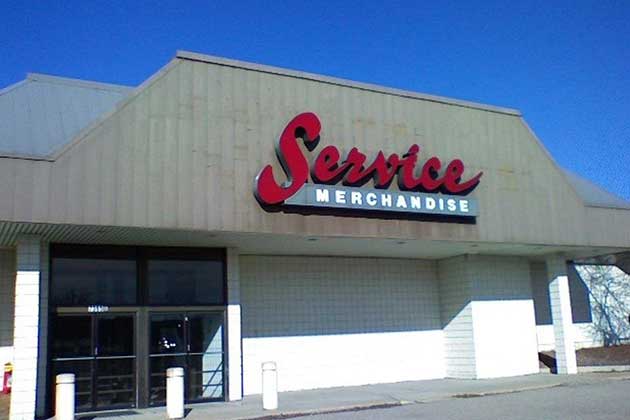
Founded in 1934 by Harry Zimmerman, Service Merchandise offered a broad range of items—including sporting goods, toys, small appliances, fine jewelry, and electronics. The stores where catalog showrooms, which differed from most retail chains. Customers would choose items from catalogs in the stores, fill out a form detailing the things they would like to purchase, and hand the form to a cashier. Employees would then retrieve the purchases from the storeroom and give them to the customer. Items on the main floor were for display purposes only.
The advantages to the catalog showroom concept were lower overhead and less employees for the stores, thus allowing them to pass on savings to the customers. Another plus was not having to carry around items for purchase while shopping. Key disadvantages for customers were the inconvenience of having to fill out the forms and having to wait to actually have purchases in hand. It might be just a few minutes, but there were instances where customers were told they would have to come back hours or even days later to pick up their purchases. Ultimately, the concept just wasn’t practical for most customers. The last stores closed their doors in 2002.
Casual Corner

West Hartford, CT was the site of the first Casual Corner location. It was founded in 1950 by Stanley Vogel and Charles Carples. The brand had expanded to 20 locations when it was sold to Unites States Shoe Corporation in 1970. The store’s original concept focused on sportswear for women but shifted to clothing for working women in the 1990s.
Casual Corner had 525 stores at its peak in 2000. Despite many successful years, the company would cite increased competition as the main reason for its eventual end. All Casual Corners locations closed their doors in 2005.
TG&Y

Named after its three founders, Rawdon Tomlinson, Enoch “Les” Gosselin, and Raymond Young, TG&Y opened in 1936 in Oklahoma City, OK. The variety store, often referred to as a five-and-dime store for its low prices, was opened with a business philosophy of “have what people want at a price they can pay.”
At its peak, there were more than 900 TG&Y stores in 29 states. Many locations were in southern states, some in relatively rural areas. The stores had a little bit of everything, appealing to adults for their low prices and children for their variety of small toys and candy. Over the years, competitors like Walmart proved to be too much for the chain to remain afloat. The last TG&Y stores closed in 2001.
A&P

Known simply as A&P, the full name of this once-massive grocery chain was called The Great Atlantic & Pacific Tea Company. A&P began in New York City in 1859. It was the largest grocery store chain in the United States from 1915 through 1975, with almost 16,000 locations in the USA and Canada at its peak in 1930.
The decline of A&P began in the early 1950s, when the grocery landscape included many competitors and more modern offerings. A&P stores seemed outdated by the 1970s and did not respond well to increasing operating costs. The chain continued with a number of changes in ownership and various attempts to revive the once-thriving stores. Depsite a historically long run, the remaining 296 A&P stores closed on November 30, 2015.
Mervyn’s

On July, 29, 1949, Melvin Morris founded a store in a planned community near San Lorenzo, CA that was supposed to be called Mervin’s. The architect working on that store suggested changing the spelling to Mervyn’s to stand out and thus be more appealing to customers.
Mervyn’s offered a no-frills store and used the reduced overhead to price items cheaper than competing department stores. The store also took advantage of deeply discounted factory seconds with minor, undetectable flaws to further reduce prices. The concept was a hit with suburban families.
Mervyn’s had 189 stores in 10 states by 2006. While most were in shopping malls, quite a few were stand-alone properties. Despite a long run as a successful department store, sales were increasingly sluggish over the years. All stores were closed by January 1, 2009. There was talk of an online only version of Mervyn’s, but that never happened.
County Seat

The name for this clothing store chain, which was founded in 1973, was a bit of a pun as it specialized in blue jeans. Jack Crocker opened the first store in Dallas. The chain had grown to 183 stores by 1977 and had expanded beyond casual clothing to include sportswear. County Seat was sold to Carson Pirie Scott, a department store chain in Chicago, for $71 million in 1983.The chain’s stores were redesigned and changed their target audience to teenagers.
Following a couple more ownership changes, County Seat seemed to have lost their identity and had a dwindling customer base. The chain filed for Chapter 11 bankruptcy protection in 1996 and began closing locations across the country. All stores were closed in 1999.
Jitney Jungle
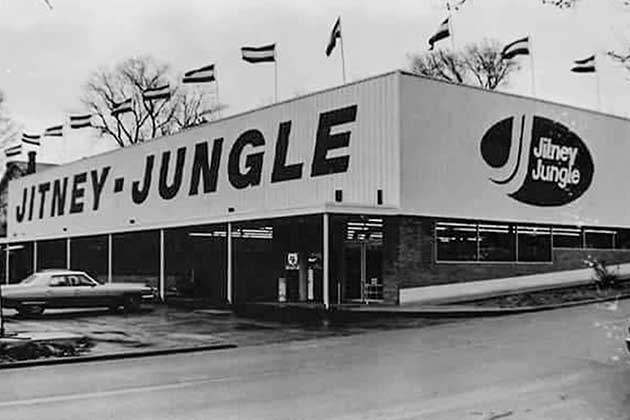
Formed in 1919 by Judson McCarty Holman, William Henry Holman, Sr., and William Bonner McCarty, Jitney Jungle began in Jackson, MS. The name was rumored to be the result of a newspaper typo for their first advertisement, but W.H. Holman, Sr. disputed this story. He said the name was a play on words based on slang of the day. The advertising slogan, “Every Jitney would be a jungle of bargains that could save the customer a ‘jitney’ on a quarter”, placed an emphasis on saving money.
The cash-and-carry grocery concept was quite successful and survived the Great Depression. There were more than 100 Jitney Jungle stores in Mississippi and surrounding states by 1992. In the mid-1990s the company merged with a New York investment firm. This would prove to be an ill-advised decision and put them deeply in debt. This and other cash-draining business decisions would lead Jitney Jungle down a path of no return. All stores were closed by 2000.
Chess King

The first Chess King opened in the Dedham Mall, just outside of Boston, in March of 1968. The lack of stores (at the time) focused on fashion for young men prompted the concept. The name was the result of market research suggesting that young men were interested in chess and auto racing. The New York Times featured an article about the store in 1970, describing the retail chain as “male apparel dress shops whose stores are highly identifiable, with bold coloring and designs aimed at appealing to the 12 to 20 male market.”
The franchise grew by leaps and bounds, opening more than 500 stores by 1984. Chess King was made for ‘80s fashion—or maybe it was the other way around. Regardless, once the decade was over there was a steady decline in sales for this retailer. All stores were closed by November 14, 1995.
B. Dalton Bookseller

The B. Dalton chain was founded in 1966 by Bruce Dayton, who decided to substitute and L for the Y in his name. The first store opened in Edina, MN, followed the next year by a second location in St. Louis, MO. The retail bookstore chain was originally planned to operate in downtowns and suburbs, but most of the stores were in shopping malls.
In 1986, 20 years after the first store opened, there were 798 locations across the United States. B. Dalton was one of the first chains to offer hardback and paperback books displayed side by side.
The company experienced rapidly declining profits in the late ‘80s, largely due to discounted pricing by rival book chains along with a decrease in new shopping malls. This led to the sale of B. Dalton stores to Barnes & Noble. Under the new ownership, the chain was reduced to 528 locations and would continue to close many more over the next few years. The last 50 locations were closed in 2013.
Merry-Go-Round

The first Merry-Go-Round store was opened by boyhood friends Leonard Weinglass and Harold Goldsmith. Founded in 1968 in Baltimore, the first store sold only blue jeans—but would soon expand to include a wide variety of trendy clothing options for women and men. The target consumer was 15-35 years old, looking to wear the very latest in clothing and accessories.
Starting at the dawn of MTV, buyers for the company would watch music videos to stay on top of trends set by bands and solo artists. This plan worked out well for Merry-Go-Round. They became known for their ability to jump on short-lived fashion fads earlier than some rival stores and moving on to the next big thing before the trend was yesterday’s news.
Primarily located in malls, and thriving throughout the ‘80s, the concept lost its luster by the mid- ‘90s. Despite having 536 locations in 1996, the company would file for bankruptcy and close all stores in that same year. The stores might not be around anymore, but the impact they had on shopping, and trend setting in general, will not be forgotten. A 2011 list by MainStreet.com ranked Merry-Go-Round among stores “gone but not forgotten”.
K&B Drugs
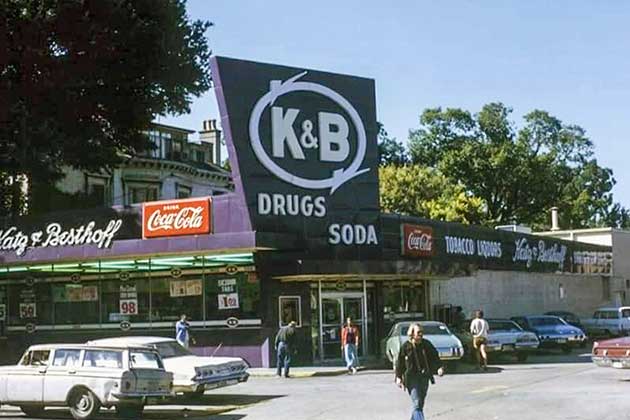
Gustave Katz and Sydney Besthoff founded a drug store on Canal St., in New Orleans, LA in 1905. The store would expand over the 20th century to become a popular regional chain. Everything related to K&B was well-known for its unique shade of purple, including signs, employee uniforms, cash registers, and K&B brand product packaging. It would come to be known as “K&B purple” and was instantly recognized in the region.
In addition to the usual drug store items, cosmetics, and photo processing, K&B was known for its private label items. This included trash cans in that special shade of purple, household goods, and regionally famous K&B ice cream. Their creole cream cheese ice cream flavor was a favorite of many customers and often out of stock. There was even K&B brand beer and liquor, with some of the liquor bearing the name YENDIS (Sidney spelled backwards). The beer was cheap and popular among college students.
The chain grew from more than 50 locations in the New Orleans area to 186 stores in six states. Unfortunately, due to increasing competition in the drug store market, the chain was struggling by the mid ‘90s. All locations were acquired by the Rite Aid chain in 1997. Some locations were converted to Rite Aid stores or other businesses, while others eventually faced demolition.
Heilig Meyers

In 1913, two Lithuanian immigrants, William A. Heilig and J.Max Meyers, opened a furniture store in Goldsboro, NC. The men were brothers-in-law and maintained a business partnership until 1946. During that period of time, they were able to expand their business and divided up the stores, with Meyers keeping the Heilig Meyers name. In 1951, the headquarters for the company moved to Richmond, VA. More stores were added, beginning in North Carolina and expanding throughout the Southeast portion of the United States.
The company went public in 1972. The ‘70s - ‘90s were profitable years for this home-furnishing chain. By 1986 the company was the largest publicly owned furniture retailer in the country, with 216 stores throughout the South. In the early to mid ‘90s, Heilig Meyers acquired 92 stores from a rival chain in the Southwest. They also bought 17 furniture stores from large furniture retailer in Puerto Rico.
The company continued purchasing other furniture chains at a rapid rate. It would prove to be the downfall of the company, combined with enormous losses from their in-house credit program. All Heilig Meyers stores were closed by April 2001.
Jay Jacobs
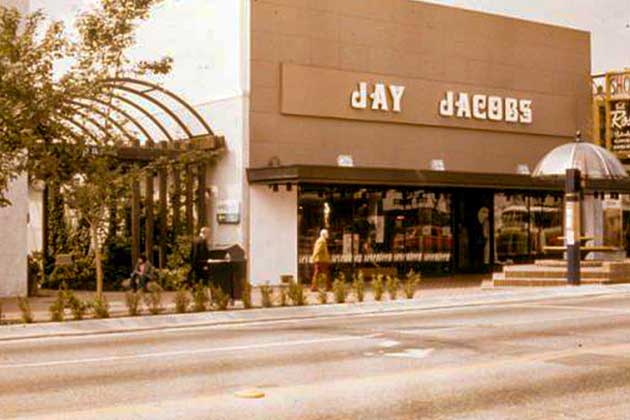
A woman’s clothing store was born in downtown Seattle in 1941, bearing the name of its founder. The progression from that single store to a retail chain was a slow process. It was a decade after the first store began that second location would open its doors. That second location was around for another decade before a third store launched. Jay Jacobs, Inc. would not be referred to as a chain until the mid-1970s. There were 10 locations in 1974, and the focus was on moderately priced clothing for young women.
The company would expand to 179 stores in 13 states by the end of the ‘80s. This number would increase to 288 stores by early 1993. Then, just as everything seemed to be on target for even further success, sales began to fall drastically. A changing retail climate and a rapid increase in stores that added more expenses than profits contributed to the demise of this once thriving mall staple. September 3, 1999 would be the end of the chain.
Today’s Man

At the age of 23, David Feld saw what he considered to be a void in the men’s market for tailored clothing. He opened his first store in Philadelphia in 1971. Shoppers could find a large selection of suits and accessories at reasonable prices. By buying in bulk, the store was able to pass on substantial savings to customers. Although often described as a discount store, Feld would characterize Today’s Man as a “merchandise-dominant specialty retail store, carrying attractive, branded merchandise.”
By 1974 there was a second Philadelphia location. In the 1980s Today’s Man would open larger stores, including its first “superstore” in Broomall, PA. Feld paid attention to the marketing techniques of superstores in other types of retail and applied what he learned to selling men’s clothing. In 1984 the stores began including more casual types of clothing for men, including sweaters, sportswear, and shoes. The company expanded rapidly with even larger stores, a Today’s Man credit card, and the addition of computers and bar codes.
The ‘90s would be a roller coaster in terms of ups and downs for the company, with a lot of downsizing near the end of the decade. The company would cease all operations on April 24, 2003. Ultimately, the cost of larger stores in locations with sky high rent would prove disastrous for Today’s Man.
Steve & Barry’s
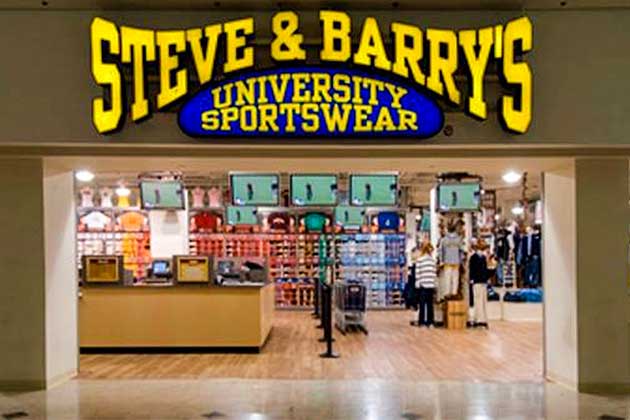
This chain started out on university campuses across the U.S. in 1985. It was founded by Steven Shore and Barry Prevor at the University of Pennsylvania, specializing in college-related clothing and casual clothing from private labels. It was originally called Steve & Barry’s University Sportswear but was later shortened to Steve & Barry’s in 2007. It was popular because of its low prices in comparison to other university stores.
In 1998, the chain opened its first mall store in Auburn Hills, MI. This store, along with those that would follow, added jeans, shoes, t-shirts, and business casual clothing to their merchandise. Steve & Barry’s was known for marketing “all-American” brands like Hershey’s Monopoly, Marvel Comics, and My Little Pony, among others. The company was the fastest-growing retailer in the United States for several years but faced a sharp decline in sales in the 2000s. With 173 stores remaining in late 2008, the company announced the liquidation of all locations.
Gimbels

Adam Gimbel opened his first department store in Vincennes, IN in 1842. The company moved to Milwaukee in 1887 and became a chain with the addition of a Philadelphia store in 1894. The company expanded to New York City in 1910. The chain was known for starting the Gimbels Thanksgiving Day Parade. Gimbels had grown to 20 stores by 1930, making it the largest department store chain in the world at that time.
The company peaked at 53 stores by 1965. The success of the chain was largely due to their ability to attract middle class Americans on a limited budget. Gimbels was featured in the 1947 movie Miracle on 34th Street, among several other film references. A diversified conglomerate in Louisville, KY would acquire Gimbels in 1973.
Over time, the new parent company decided Gimbels showed little potential for increased profits and was only a marginal performer among their many acquisitions. They decided to close all Gimbels stores in 1986. Some locations were taken over by other department stores. The downtown Milwaukee property had a major remodel in 1998, now housing a fitness club, a variety of offices, and an extended stay hotel.
The Nature Company
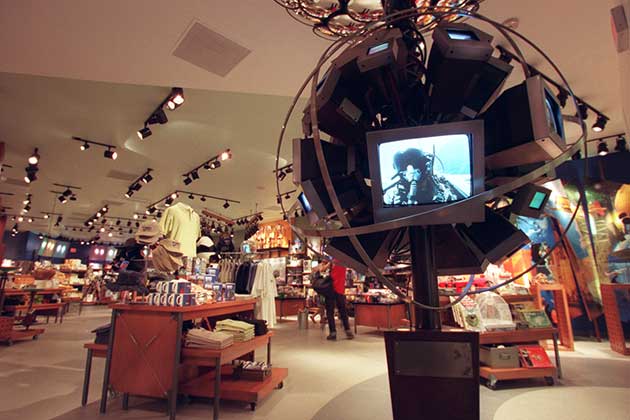
Founded in 1972 by Tom and Priscilla Wrubel, The Nature Company’s first store opened in Berkeley, CA. The store offered hands-on displays of fossils, minerals and gems, nature-themed artwork, scientific toys, telescopes, and maps. As the store became a chain, these retail spaces were easily recognizable with arched stone entryways and various water features, customized for each individual location.
The Nature Company would grow to include stores in airports, shopping malls, and downtown shopping areas. In 1996, the chain was purchased by Discovery Channel for $40 million. About 75% of The Nature Company stores were converted to Discovery Channel stores, with the remaining locations closing. All stores were closed by the end of 2001.
Zayre

Brothers Max and Morris Feldberg had retail experience behind them when they decided to open a large discount store in Hyannis, MA. It opened on June 1956 and would open up a second location in Boston in September of that same year. Future stores would range in size from 70,000 to 90,000 square feet, offering a wide variety of discounted items. In the early 1970s the slogan for the stores was, “Compare. You can’t do better than Zayre.” As one of only a few stores open 24 hours a day during the weeks leading up to Christmas, December was a highly profitable month for Zayre.
Over the next few decades, Zayre Corp. would acquire BJ’s Wholesale Club, Beaconway Fabrics, Hit or Miss, Home Club, T.J. Maxx, and Spree! Toy Stores. Zayre faced a number of challenges, including declining profits and inferiority in technological areas. Zayre Corp. decided to focus on other stores under their umbrella and sold the entire chain of almost 400 Zayre stores to Ames Department Stores, Inc. in October 1988. By 1990, there were no more Zayre stores. All locations had been closed or converted into Ames stores. Zayre had once been the fifth largest discount retail chain in the United States.
Zany Brainy
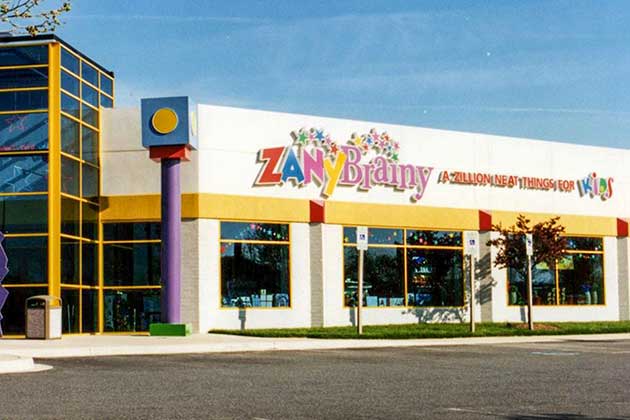
David Schlessinger founded Zany Brainy in 1991. Famous toy retailer FAO Schwartz was the parent company. The chain sold educational toys, including a wide variety of games and puzzles, building toys and trains, books, musical instruments, science toys, and computer software. One draw for customers was daily events at each store that ranged from workshops to book signings and concerts.
Zany Brainy faced financial difficulties after acquiring rival chain Noodle Kidoodle in 2000. On May 15, 2001, the company filed for Chapter 11 bankruptcy protection. Later that year, all assets were sold. There were 187 Zany Brainy locations across the United States when the chain closed.
Kinney Shoes
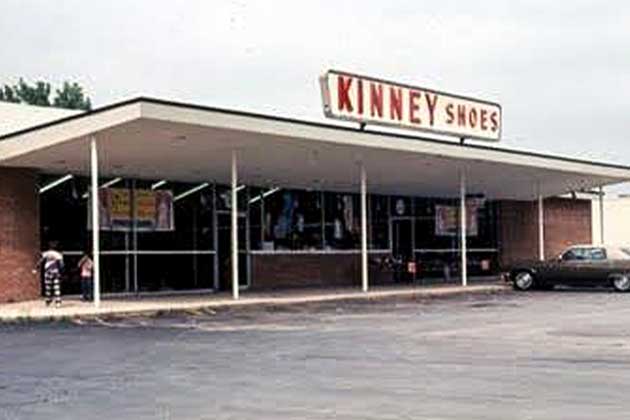
The first Kinney Shoes opened in 1894 in Waverly, NY by George Romanta Kinney. He grew up learning about retail from his father. The elder Kinney ran a general store in Candor, NY until his untimely death when George was 9 years old. At the age of 28, George Kinney had saved enough money to purchase his own retail location and began selling affordably priced shoes to middle class Americans.
Kinney revolutionized the shoe-shopping experience by offering a large and diverse inventory of reasonably priced shoes. With 335 locations across the U.S., Kinney Shoes was the largest chain family shoe retailer at the beginning of 1936. The chain was selling more shoes by the end of that year, but profits were beginning to take a dip.
Kinney shoes was sold to F.W. Woolworth in 1963. On September 16, 1998, Woolworth’s successor, the Venator Group, announced that Kinney’s 467 shoe stores would close. Foot Locker, a division of the company, remains operational and carries Kinney trademarks on a selection of shoes in their stores.
Otasco

The first Otasco store was opened in 1918 by three Lithuanian immigrant brothers, Sam, Maurice, and Herman Sanditen, in Okmulgee, OK. They moved the company headquarters to Tulsa in 1925. The business model was largely based on offering a credit plan for its variety of auto parts and appliances. The McCrory Corporation bought the company in 1960, keeping the Sanditen brothers in management positions.
Otasco spanned across 12 states with 455 stores by 1968. The chain would become one of the largest employee-owned companies in the United States in 1984, when employees bought Otasco from McCrory. This status would be short-lived, however. There would be less than 180 stores still open in 1988 when the company filed for bankruptcy.
Western Auto
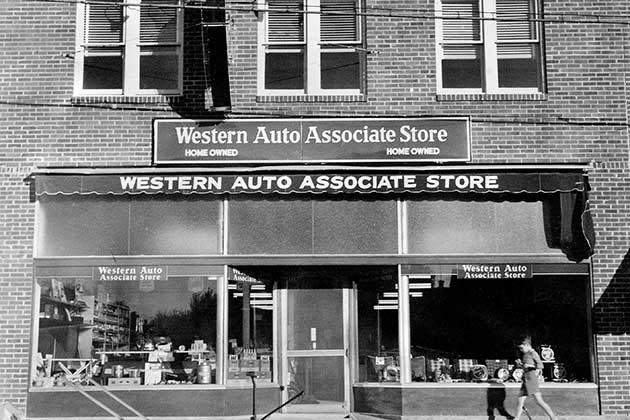
In 1909 George Pepperdine and Don Abnor Davis started Western Auto Supply Company in Kansas City. The store was originally a mail order business which specialized in replacement auto parts. The first store opened in 1921 and offered automobile parts and accessories. Cars were becoming more common, contributing to the growth of the company.
At its peak, there were more than 1,200 company-owned Western Auto locations, primarily in larger cities. There were also more than 4,000 associate stores that were franchised and usually located in small towns. This pioneering program would lead the way for modern-day franchise operations. Western Auto brands helped put the company on the map. The Western Flyer bicycle and Performance Radial GT tires were popular among consumers.
The company was sold to Beneficial Finance Corporation in 1961, then Wesray Capital Corporation in 1985, followed by Sears Roebuck in 1988. During this period of time, the number of locations had decreased considerably. An ill-fated merger with Advance Auto, along with stiff competition from Walmart and newer auto part rivals, led to the end of Westen Auto in 2003.
Woolco
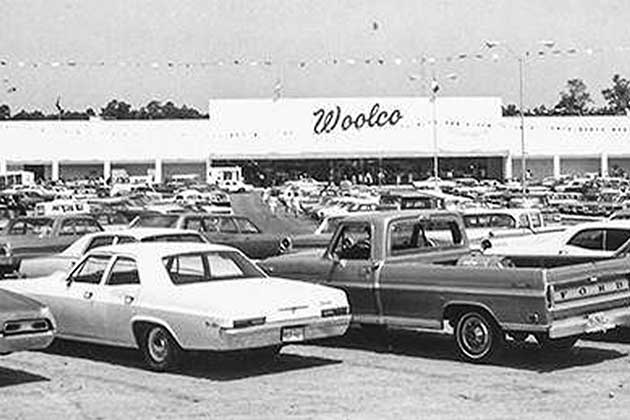
Founded in Columbus, OH by the F.W. Woolworth Company in 1962, Woolco was a discount department store. The chain was different from the five-and-dime Woolworth stores, offering a broader shopping experience. Woolco sold bedding, furniture, clothing, shoes, electronics, health & beauty products, toys, and household items.
The expansion of the stores was closely tied to expanding suburban markets. Quite a few locations had Red Grille restaurants. It was a cafeteria-style eatery, with areas that sold popcorn, milkshakes, and other food options. Most Woolco stores were in excess of 100,000 square feet, which was considerably larger than most of their rivals. Beginning in the late 1970s, Woolworth focused on cost saving and smaller locations. This led to a reduction in inventory and seemed like a step back to customers.
By 1979, Woolco was losing money and the parent company decided to combine some stores with their Woolworth variety stores. Other locations were closed. This effort was not enough to save Woolco. All 336 stores in the United States were closed in January 1983.
Bonwit Teller

Following the failure of a hat shop in New York City, Paul Bonwit opened a new store with a partner, Edmund D. Teller, in 1898. Incorporating their business in 1907 as Bonwit Teller & Company, the store would relocate in 1911 to the corner of Fifth Ave. and Thirty-eighth St. The store offered high-end clothing for women that was recognized in the industry as being high quality. They were also known for paying their buyers and executives higher than average salaries. The store would move to a new address on Fifth Ave., further uptown, in 1930. This would be the company’s flagship location for almost 50 years.
A revolving door of ownership over the years would lead to significant growth for the company but would also prove to be its downfall. In 1980, Donald Trump would purchase the flagship location. Despite promising to save the iconic pillars and other valuable artistic aspects of the building for a donation to the Metropolitan Museum of Art, the entire building was destroyed. There was an outcry from the public who had loved the distinctive sculptures of the building for years.
The remaining locations were ultimately sold to The Pyramid Company in 1990. Plans to revive struggling Bonwit Teller stores never materialized. The last remaining store, in Syracuse, NY, closed in March 2000.
Hancock Fabrics

L.D. and Elaine Hancock founded Hancock Fabrics in 1957 in Tupelo, MS. The store offered low prices on fabric and craft items. Lucky Stores purchased the chain in 1971. At that time the chain had 81 stores, with 265 more franchise stores in 19 states. In 1985 the company also acquired Minnesota Fabrics, a North Carolina based chain with over 100 stores under the names Fabric Warehouse and Minnesota Fabrics.
The company was one of seven major fabric/craft stores in the United States by 1992, with almost 500 locations. Still, the success could not be sustained among a tightly competitive market. The company would close 104 stores in 2008. All remaining assets were approved for sale by the U.S. Bankruptcy Court in April 2016. The last 185 stores were closed and all assets were liquidated. In 2016, Michaels Stores, Inc. acquired the intellectual property and customer database of Hancock Fabrics.
 Author
Sherrill Dean
Last Updated: November 29, 2023
Author
Sherrill Dean
Last Updated: November 29, 2023

